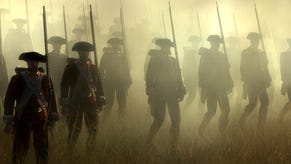Empire: Total War
18th Century Boy.
It seems appropriate, writing about a Total War game, to start off with a quote from Sun Tzu. Having pored through Wikiquote for a few more minutes than I'd intended - his Art of War really is bite-sized entertainment, even to flaky real-life pacifists like myself - I settled on "You cannot stop innovation". It's not the most colourful quote, but as Empire marks the biggest leap in innovation since the first Total War game, it seems more relevant than the strange stuff about building your enemies a golden bridge to retreat across. Golden bridges? That'd be really slow and expensive. Idiot.
So, a recap: Empire is set over the entire 18th Century, on a map from India to America. It's a time when new weaponry was beginning to shift the emphasis of battles away from melee and mounted combat. Not completely, of course - bayonets were still being used in the trenches of the 20th Century, and horses still have their role. They're just not used to run through the middle of troops. War in Empire is different.
Trade will be vital, as ever - and diplomacy will take a stronger role in the new game, as it did in the period itself. This means that Creative Assembly will have to reign in some of the AI's brasher decisions. Previously, diplomacy has occasionally felt something of an irrelevance, beyond trade deals. Occasionally, the AI rejected fair offers in the face of certain defeat. Brilliance on dozens of levels taken as a given - and they are staggeringly brilliant games - this was a recurring annoyance.
But diplomatic nuance isn't what's on display in Creative Assembly's Horsham offices, as six people file into a room with five computers, to play a 2v2 match. As fans will know, Empire: Total War's most striking innovation is the introduction of naval combat. And that's what we're playing today.
First, we're shown a demo, which introduces us to the basics of maritime warfare. Each ship has sail strength, and a hull strength bar for each side of the ship. A flag indicates the allegiance, and flashes white when your morale has been sapped to the point of retreat, and around the selected ship's base is a compass, displaying the direction of the wind. All of this is useful in deciding what to do - don't present a weak side to the enemy, take advantage of superior control if you see your opponent's sails are damaged, and if the wind's in your favour, use it.

I took France's seat. A generous sixty-second deployment phase was a bit long for my three ships, but full battles will feature more like twenty. Having positioned my boats in a straight line, I was told that this was a tactical mistake; I was directed to fan out. My ships spreading out like an Atari logo, I fired chain-shot to take out my opponents' masts. Chain shot is automatically fired higher, and is designed to reduce your opponents' mobility by destroying their sails. Round shot - Cannonballs Classique - are fired more directly at the hull, and go towards sinking the ship, and taking out the crew manning that hull's cannon. Grape shot, meanwhile, is designed for use at close range, as a prelude to - or a reaction against - boarding. Boarding may not be easy, but will be worth it in a longer game. You win the opponent's ship, and any technology they may have that you're missing.
So, while I focused on their sails, Spain had been training their broadsides on my hull - causing more immediately debilitating damage, and causing my sailors to become flummoxed. Flummoxed, to the point where they refused to carry on fighting. My advisor seemed baffled that the French had been the first to rout all morning, giving me the chance for an easy and racist joke that I'm still proud not to have kept inside my awful head.
The ships we're using are limited. The full game will have many more. Rocket ships (invented around 1780) will have the ability to spread fire across the deck of opposing ships, and in the final game, you'll control many more ships, such as frigates, sloops, brigs. First-rates like Nelson's 104-gun ship the HMS Victory (still preserved at Portsmouth) will feature, as will oversized versions of these mighty ships. These buggers can house 136 guns, giving them the power to properly muck up a bunch of junks - the downside being a turning circle with the diameter of Britain.











